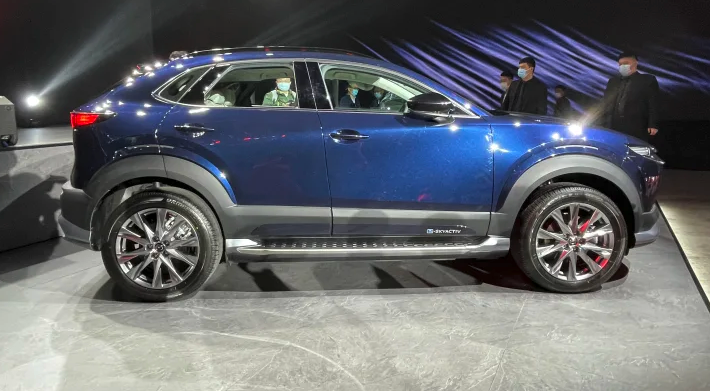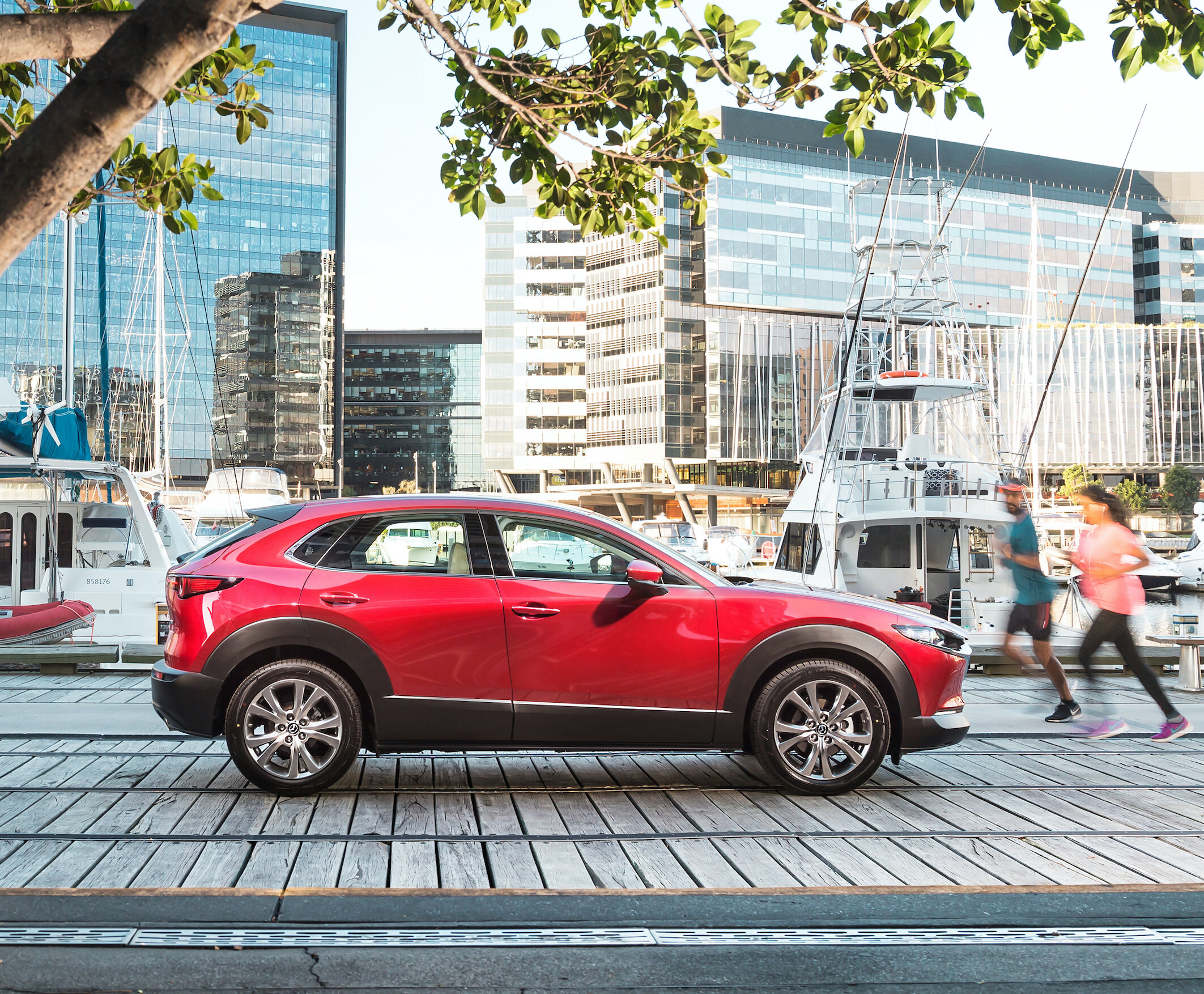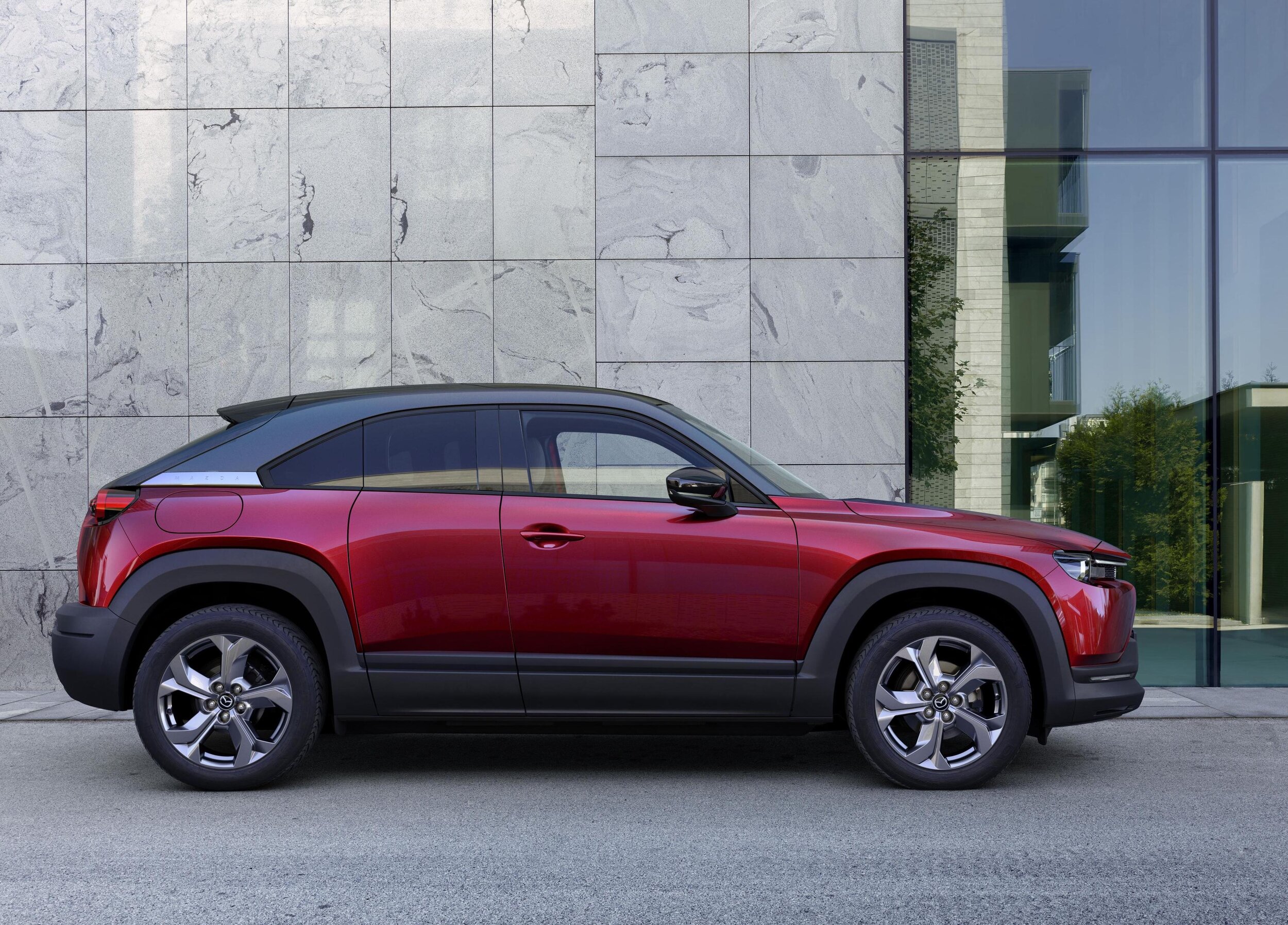CX-30 facelift details shared
/Minor changes are coming to Mazda’s smallest crossover.
Read MoreMinor changes are coming to Mazda’s smallest crossover.
Read MoreEnergy-recuperating system now on CX-30.
Read More
The CX-30 EV at the Shanghai motor show, above, is a derivative of the petrol edition popular with Kiwis (below) that appears to run the same drivetrain as the MX-30 Electric (bottom) about to release in New Zealand.


MAZDA’S electric vehicle family has doubled, but chances of one day seeing the ‘second child’ CX-30 in New Zealand alongside the battery-fed MX-30 about to go on sale here seem slim at best.
The fully mains reliant version of the CX-30 unveiled at the Shanghai motor show yesterday would conceivably attract Kiwi interest, as the petrol versions on sale here are popular sellers.
However, Mazda Japan has made clear the new car – called CX-30 EV - is for China only at this point.
That point is reinforced by it being set to be produced solely by the brand's Changan Mazda joint venture in Nanjing, China, rather than in Japan, the sourcing point for all Mazda NZ’s passenger product.
Despite having very different body styles – the MX-30 being more rakish and noteworthy for having pillar-less freestyle doors, which open outwards from the central B-pillar point – the MX-30 and the CX-30 are closely related.
Both are based on a common architecture, also shared with the Mazda3, and physical dimensions are very close.
The MX-30 formats in two distinct drivetrain provisions – there is one model designed to run with petrol engine-assisted hybrid and another that avails in full electric. Both are destined for New Zealand availability, pricing yet unknown.
The CX-30 EV also appears to share technology with the expressly battery MX-30 Electric.
The MX-30 MX Hybrid, meantime, is powered by a 2.0-litre, four-cylinder petrol engine paired to Mazda's M Hybrid system, producing maximum outputs of 114kW and 200Nm through a six-speed automatic transmission sending power to the front wheels only.
The addition of the mild-hybrid system means the model's official fuel consumption figure is reduced to a claimed 6.4L/100km on a combined cycle.
The MX-30 Electric looks much the same as the mild hybrid car, save for some subtle electric badging on the exterior and a combined AC/DC charging point where the fuel cap would normally be – on the rear right-hand side of the vehicle.
The electric model is powered by a 107kW/271Nm electric motor on the front axle and boasts a 35.5kWh lithium-ion battery pack mounted beneath the floor. It is thought the CX-30 EV has the same powertrain.
The MX-30 Electric is capable of up to 200km on a single charge according to the World harmonised Light vehicle Testing Procedure (WLTP). The CX-30 EV is thought to have the same range, which is notably lower than some key competitors, like the Hyundai Kona EV, which has 484kms on WLTP.
Styling differences between the CX-30 EV and regular model that Kiwis know are minimal, though the placement of the battery pack under the floor means the electric model rides somewhat higher than its petrol-powered counterpart. It runs on 19-inch wheels and has 'e-SkyActiv' badging.
It is not clear if the CX-30 EV could provision as the MX-30 Electric also ultimately will, with a petrol-fed rotary engine range-extender drivetrain.

A small displacement Roots-type supercharger assists with the high volume of air needed for ultra-lean combustion.
‘CROSSOVER’ has become a modern automotive buzzword.
Mazda has developed a crossover engine – one which runs on petrol but has combustion characteristics more closely aligned to diesel.
And to emphasise the achievement it’s applied the X-suffix to its SkyActiv nomenclature.
The new 2.0-litre SkyActiv-X delivers the throttle response and revving characteristics of a petrol engine with the high torque and low consumption attributes of a diesel.
It’s a practical application of the Homogeneous Charge Compression Ignition (HCCI) petrol engine principle in which a very lean air:fuel mixture reacts spontaneously to heat and pressure during the compression stroke.
To-date HCCI has been considered impractical for production vehicles because they work in a narrow range of conditions. Variations in atmospheric pressure, temperature and fuel quality can result in destructive pre-ignition and detonation.
Mazda’s clever solution has been to add spark control to an engine that theoretically shouldn’t require a spark plug along with a world-first application of in-cylinder pressure sensors.
The SkyActiv-X engine achieves both spark ignition and compression ignition and can move between modes.
Mazda calls the technology SPark Controlled Compression Ignition (SPCCI). The new engine has a very high 16.3:1 static compression ratio and operates at extremely lean air:fuel mixtures.
The theoretical ideal for gasoline engines is to burn a 14.7:1 air:fuel ratio - known as stoichiometric - which defines that all fuel is burnt without excess air.
SkyActiv-X can operate at ratios more than twice as lean (higher than 30:1) – a scenario in which a spark plug would be unable to ignite the lean mixture.

SkyActiv engine production is now at full steam
In SkyActiv-X the spark plug is used to initiate and control combustion. As the piston is compressing the ultra-lean mixture the engine control systems are monitoring cylinder pressure and combustion is initiated with a small and precisely timed atomised fuel charge being injected close to the spark plug.
When ignited it creates an expanding fireball (Mazda calls this an air piston) that rapidly raises the pressure and temperature in the combustion chamber to the point where the much leaner mixture is ignited.
Mazda says size and timing of the fireball is being constantly altered. At cold start and under high revs/high load conditions the engine primarily works in spark ignition mode.
Across a range of normal driving conditions, it is estimated the engine operates in SPCCI mode about 90 per cent of time.
The extremely lean mixture burns cooler which in turn reduces temperature differences in the cylinder head, piston and cylinder walls. The cooler combustion also significantly reduces the formation of nitrogen oxides (NOx).
Along with less fuel the engine also requires more air for which the solution is a small displacement, belt-driven ‘‘Roots’’ type supercharger.

Mazda's MZ-D Connect centre display provides confirmation of when the SkyActiv-X engine is running in SPCCI mode.
In common with the familiar SkyActiv-G 2.0-litre direct injection petrol unit, the SkyActiv-X measures 1998cc displacement. The engines share much of their block and bore/stroke architecture but a new cylinder head has been designed for SkyActiv-X.
Peak power is 132kW at 6000rpm (compared to the current 2.0-litre SkyActiv-G developing 114kW) along with 224Nm of torque at 3000rpm (up from 200Nm and arriving 1000rpm earlier than current SkyActiv-G engines).
When its powering a six-speed auto Mazda3 hatch on 18-inch alloy wheels the fuel consumption is rated at 5.8L/100km (WLTP test procedure) and Mazda estimates an overall consumption improvement in the region of 15 to 17 per cent along with corresponding CO2 emission improvements.
There’s also a Mild Hybrid contribution to the SkyActiv-X efficiency equation with a belt-driven 24-volt integrated starter/generator system. It assists with engine starting, initial movement away from stationary and bolsters the lower portion of the torque curve.
Hybrid output is rated at 4.8kW of power at 1000rpm with a 60.5Nm torque boost at just 200rpm.
To support the new engine characteristics the gear ratios have been altered. The SPCCI engine doesn’t conform to a normal pattern of increased fuel usage as engine revs increase so shorter gear ratios allow the engine to rev a little higher and provide improved response and a sportier character.
While Mazda has achieved a petrol engine breakthrough with its SkyActiv-X technology, the company says diesel engine vehicles will continue and there is a second generation SkyActiv-D diesel family expected to be announced in the near future.

the Mazda3 (above) and CX-30 are first candidates for this new engine technology.

WHEN space is tight, muscle in – that’s the tactic Mazda has employed with it its latest addition to the CX family.
In advance of an on-line discussion tomorrow where strategies are expected to be outlined, the Auckland domiciled brand has released specification and pricing detail of its CX-30 five-seater elevated crossover hatch.
The information confirms it will initially foot three versions, with a Takami flagship following in the second half of 2020.
Those here now have drivetrains already used elsewhere in the family - though CX-30’s versions of the SkyActive-G petrols are finessed for slightly different outputs – whereas the Takami will introduce the new SkyActiv-X tech.
The coupe-like styling delivers a new spin on the established Kodo styling. A more modern platform and enhanced versions of the driver assist and comfort tech that comes in other Mazdas also feature.
Also interesting is the price positioning of the base GSX front-drive, with a 140kW/200Nm 2.0-litre engine, and a pair of 140kW/252Nm 2.5-litre all-wheel-variants, badged GTX and Limited.
The recommended retails of $41,490, $44,990 and $50,990 further cement that, in order to make room for a car that would have been called CX-4 - had that designation not gone to a model developed purely for China - the product planners had to work beyond the clear air that existed between the CX-3 and CX-5, which defy the CX-30’s ‘first ever’ marketing tag (insisted because it goes a bit more coupe-like) by very obviously being sister cars.

The newcomer’s potential to pluck sales from each camp has always seemed strong – it’s bigger and better-kitted than the CX-3 and more modern and arguably more stylish, inside and out, than the CX-5 and nips ahead on core safety and assist considerations. Any advantage with the latter should be a fleeting, as updates to CX-5 have been announced in other markets.
However, the pricing plan is bound to raise interest, as it establishes the newcomer with a foot in each existing camp.
Consumers eyeing up the entry CX-30 will note it is $205 cheaper than a CX-3 Takami but otherwise dearer than the less well-provisioned editions of the smallest Mazda rock hopper.
Consideration against the CX-5 reveals more to think about, as the incursion is more pronounced.
Keeping comparison to just petrol all-wheel-drive options seems only reasonable – there are two CX-5s with a turbodiesel, but that engine is not on CX-30’s horizon.
Anyway, if customers chasing the most expensive CX-30, the Limited, are looking to see how it stacks up against CX-5, they’ll see it basically sits midway between the base and Limited editions of the larger model.
So there’s that to consider. Then there’s the size. The CX-30 was developed through recognition some customers think the CX-3 is a bit too small and the CX-5 a bit too big.
If actual dimensions are required to get a true feel for where it stands, then note that at 4395mm long and 1795mm wide, the CX-30 is 120mm longer and 30mm wider than a CX-3 and 155mm shorter, 45mm narrower and 150mm lower than a CX-5.
A first appraisal – prior to shut down – showed it’s roomier than the smaller car, more snug than the larger, but by less of a margin. Basically, it eats the CX-3 as a four to five seater, but is so close to being up to CX-5 level that it will create significant discussion about rear seat, head space and lower leg room.

Same goes when comparing cargo room. CX-30’s seats-up boot space of 317 litres above the boot floor is a useful 53L over the CX-3, while using underfloor storage brings the total to 430L on most variants. That’s just 12 litres short of the CX-5’s cited capacity.
As for spec? Yes, the GSX and GTX grades are more workmanlike, inside and out, but really only stand apart by having cloth trim (whereas the Limited steps up to black leather) and smaller wheels with less sporty tyres.
That first look suggests cabin environments are common and all variants have blind spot monitoring, lane departure warning and lane keep assist, radar cruise control with Stop and Go, rear cross traffic alert, reversing camera, traffic sign recognition and smart brake support.
but the latest Mazda Connect infotainment system, with integrated satellite navigation plus phone-mirroring technologies Apple CarPlay and Android Auto, via an 8.8-inch wide-screen centre display, spans the family.
A high plaudit from our only recognized safety auditor, the Australasian New Car Assessment Programme, also goes to all models. ANCAP has given it a record near-perfect 99 percent score for passive safety in adult occupant protection and a five-star rating.
When it comes to considering how they perform, everything might come down to driving feel rather than outputs, because the one common link between all three is under their bonnets.
The 2.0-litre in the CX-30 is also employed by the CX-3 – where the state of tune is lower - and entry CX-5, where the outputs are identical to those claimed for the new car.
The 2.5-litre engine in CX-30 only otherwise goes into CX-5. It makes the same torque output in either application and there’s just 1kW power difference. All have six-speed automatics. The CX-30 all-wheel-drive system is like that in the CX-5 2.5

With all this going on, Mazda NZ managing director Dave Hodge is patently not understating anything in proposing that this latest and fifth crossover has had to “create its own space in the small SUV segment”
Nonetheless, in comment sent out ahead of the on-line conference he suggests CX-30 will be able to chart its own course with confidence through having “the practicality of an SUV combined with coupé-like styling and dynamic handling inspired by its small car sibling, Mazda3.”
Proposing the car as complete package for customers looking for a practical, stylish vehicle without compromising on performance, he suggests it will do well simply from having a more modern interior than the CX cars positioned on either side of it and also from touting the most advanced systems and technology.
Integral to CX-30’s drive experience is Mazda’s G-Vectoring Control Plus (GVC Plus) which sets out to enhance handling stability by using brake and engine control to help the vehicle respond to sudden steering inputs and give the driver confidence when cornering.
The CX-30’s 2.5-litre also have cylinder deactivation, which contributes to fuel economy by shutting-down the outer two cylinders when driving at constant speeds, and the all-wheel-drive has 27 sensors that monitor environmental and vehicle conditions at a computation rate of 200 times per second to predict traction requirements before wheel slip occurs.

MotoringNZ reviews new cars and keeps readers up-to-date with the latest developments on the auto industry. All the major brands are represented. The site is owned and edited by New Zealand motoring journalist Richard Bosselman.